PARISH OF MAGHERALIN
by Kieran Clendinning
The parish churches of the Diocese of Dromore, in
particular that of the ancient parish of Magheralin., are a vital part
of our heritage demanding to be seen, not only in terms of architecture
but as institutions, places of worship within a pattern of settlement
with a role in the history and worship of the community.
Situated on the western reaches of the River Lagan,
at a point where the river turns east to navigate its course through the
verdant Lagan Valley, the Parish of Magheralin. has stood sentinel-like
as a beacon of Christian faith from the mission of Patrick, who
according to tradition used the Lagan as the highway on his journey
through Iveagh to Dromore. A second aspect of Magheralin., Machaire
Lainne, (the plain of the church) linking the dawning of Christianity in
this ancient homeland of the O'Labhradha of Magh Rath, is that it is
identified in the annals as `Lann Ronain Fhinn in Uibh Eachach Uladh'.
It was originally claimed that Colman founded the 7th. century monastic
settlement. His death is recorded in the annals as follows "The Age of
Christ, 699. The sixth year of Loingseach, Colman of Linn Ua-Chaille,
died 30th. of March." The belief that this Colman was the founder of the
monastery was born out of a suggestion by some scholars. This was later
corrected when it was found that Magheralin. had been erroneously named
as being the settlement of St. Colman sited close to Linduachaill, at
Annagassan, in Co. Louth.
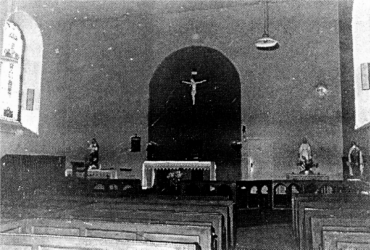
St. Patrick's Church,
Magheralin.
The first clue to the patron of the parish can be
found in the early manuscript Felire Oengusso Celi D�. Written in 800
A.D. the manuscript known in English as The Martyrology of Oengus, lists
Ronan eighth in descent from Colla da-Chrioch as the founder: "The soul
of Ronan the Fair went to the starry heaven, with the bright prolific
man, Baithene son of Finda'' suggesting that sometime in the year 637,
Ronan Finn built his first church at Magheralin.. The date of his demise
is given in the Calendar of the Saints of Ireland as the 22nd. May 637,
under the following heading Ronan Finn, of Lan Ronain Finn, in Ui
Eachach Uladh.
In old Irish, the word Lann is used to denote a house
or a church, and is borrowed from the Welsh. The use of the word as
applied to Ronan's settlement on the banks of the Lagan dates back to
the second wave of missionary activity in the area in the 7th. century.
Besides Lann Ronan Finn, there are three other ancient Lann churches
sited in the greater Killultagh district. They are Lann Abhaic, (church
of the dwarf) at Glenavy; Lann Lua, "the church of MoLua" at Lower
Ballinderry and Lann Beg "the small church," at Lambeg. Another proof of
the Welsh connection with Dromore in early times is the fact that
Colman, of Nedrum, the apostle of St. Patrick and patron saint of the
diocese, is also the titular saint of Langolman.
In an age when the paruchiae of Celtic monasticism
accepted Episcopal orders, and had it not been a fact that the Normans
were entrenched at Dromore at the time of the Gregorian reform, it is
more than a probability that the abbot of Lann Ronan Finn, would have
been a strong contender to become the prelate of the newly-formed
diocese. Long after the enactment of the Gregorian reform, the
pre-eminence of Magheralin. was maintained through the establishment of
the prebendary of Lann Ronan with a stall in the Chapter of Dromore
Cathedral. The ecclesiastical importance of Magheralin. can also be
stressed by the fact that the English establishment in 1660, thought it
expedient for the Anglican Church - after the Puritan purge of Cromwell
- to build a See-House at Magheralin., and refurbish the ancient church
as a pro-Cathedral for the administration of the Protestant Diocese of
Dromore.

THE CLOUGH RUA
Shadowy details are all that are available of the
early monastic community at Magheralin.. Yet it continued to exist up to
the 12th. century. The first clear evidence of the settlement appears in
1178 when the annals record that John de Courcey plundered the "ardneimheadh
Uladh wile, the chief sanctuary of Ulster, and Thomas O'Corcrain, the
erenach of church of Lann Ronan, was beheaded. The result of this
desecration meant that many relics were destroyed, including the
treasured 400-year old bachal, or crozier of St. Ronan. Despite this
annihilation, Ronan's bell known as the Clough Rua was saved and
carefully preserved by its hereditary keepers the Roe-Lavery of
Magherahinch. During the penal times the bell was placed in Moira Castle
and its safety entrusted to Earl of Moira. The bell was eventually
returned to the parish at the opening of St. Colman's Church on 24th.
October 1841. The bell is now in the National Museum of Antiquities of
Scotland.
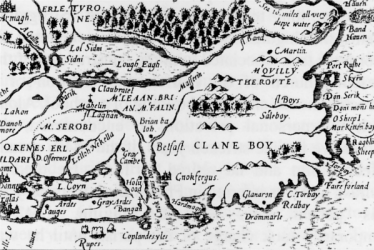
Northern Ireland, from
Jodocus Hondius, Hyberniae novissima descriptio (Amsterdam_ 15911
On the map of 1591 (above), Magheralin. (Mahelin)
takes pride of place on the River Lagan. Donaghcloney and Dromore are
not included. On the map of 1610 (below), all three ancient
ecclesiastical foundations are included but the territory of Kilwarlin
is even more prominent.
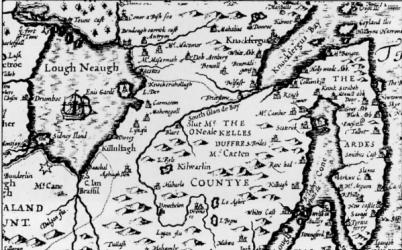
From The province Ulster
described. 1610. in Speed's Theatre.
Another important reference to the early church is
the well known as "Tober Ronan". This is sited in a field close to the
Moira Road, in the townland of Ballymagin, Baile Mhig Flinn. This was
church land, a fact that is still recorded in the use of the word
Temple, Teampall, a church. While the ancient manuscript known as the
Book of Lecan locates Ronan's community at "Corco Rusen in Magh Rath"
the exact site of early church is unknown. While there are difficulties
in establishing the whereabouts of the monastery above ground, it can be
hinted that Ronan had established his community in Feney, where the
Survey of Down informs us that the 1835 Ordnance Survey Map "traces the
outline of a rectilinear earthworks at a part where a small stream
enters the Lagan." In medieval times, the focus of settlement centred
around An Temple Machaire Lainne." It was this demographic contraction
and social change that led to the placing of the parish church at
Ballymaginn, leaving the old timber-built monastic complex at Feney to
fall into disuse. The land at Feney, Fionaigh, belonged to the
O'Labhradha but this was confiscated by the Commonwealth and taken from
Rory Curragh O'Lawy of Ffowney who was implicated as an insurgent during
the 1641 uprising.

In the 15th. century owing to the sparseness of
numbers, Magheralin. was united with the parish of Aghalee by Papal
decree. To cement this union, Donatus Magynd (Donald Maginn) who held
the Prebendary of "St Ronan's of Land" was appointed vicar of Acadle in
1492. Nevertheless, records from the 12th. to the beginning of the 17th.
century show that Patrick Magind, vicar of Magheralin., was appointed to
the Cathedral Chapter of Dromore to hold the prebendary of "St. Ronan's
de land, 27th. March 1407," His elevation also included his induction as
Rector of Clonduff. Some 15 years later, a John Magynd is recorded as
vicar of Magheralin. in 1422. The next vacancy was held by Marcus Mac
Bridyn. He resigned in November 1429 before the Papal Bull of his
appointment had been issued. This Marcus MacBridyn is also credited as
being rector of Clonduff in 1428. In 1440, Ode O'Ronaga (O'Rooney) was
provided with the living, but his appointment appears to have been
short-lived for he was followed by John MacGgynd in 1442. Christopher
McFremior (Treanor) vacated the prebendary on his death in 1477. For
three years after the death of Mac Fremior, Magheralin. was held by
Donald Magynd, already mentioned above, until appointed to the
prebendary, 4th. July 1480. He was followed by the appointment of Arthur
Magynd Archdeacon of Dromore and Rector of Tullylish in 1526. From 1407
to 1526, there were eight Canons holding Magheralin.. five of whom,
belonged to the established clerical family of Maginn. The names and
dates of appointments at this period to the present are recorded as
follows:-

During the 17th. century when the Church was
proscribed, nothing was noted until 1651, when a mendicant, Friar Lavery
was officiating in his native parish, Nothing more is heard of
Magheralin. for another 40-years when two priests, Murtagh O'Lavery and
James Bane MacOwen, both natives of Magheralin., were attainted and
deprived of rights by conviction of treason at Downpatrick, October
1691. Murtagh O'Lavery was ordained in Dr. Daniel McKey, Bishop of Down
and Connor, in 1673. When he was compelled to register at Downpatrick
11th. July, 1704 he was described as the "Pretended Popish Priest of
Dromore and Magheralin.." It is interesting to note that at Downpatrick
in 1704, the Reverend' Patrick Macllmurray, was registered as Parish
Priest of Carn in (Seagoe Parish), Aghalee and Aghagallon. He was then
aged 47, and stated to have been ordained by Bishop Oliver Plunkett at
Ardpatrick, Co. Meath,in 1679. His sureties were Herny Magill,
gentleman, of Aghagallon, and David McLerinon, yeoman, each for the sum
of fifty pounds. Again Reverend Daniel O'Mulhollan, registered as
residing in Magheralin., is recorded as parish priest of Drumalle,
Antrim, Donegore and Shealewood. In 1720, not only was a Father Downey
recorded as Parish Priest of Magheralin., his charge also included the
parishes of Dromore, Magherally, Garvaghy and Seapatrick. The report
compiled by the Protestant hierarchy on the "State of Popery in the
Dromore Diocese" notes that there were three priests residing in the
parish of Magheralin. in 1731. Sometime later in the 1730s, but before
1738, Magheralin. was held by the Reverend Father Tighe, and while it
was unfashionable and somewhat illegal at time, he was a regular guest
of Sir John Rawdon at Moira Castle.
Among the native priests who dedicated their lives to
the people was Reverend Fr. Lavery, Parish Priest of Magheralin. and
Dromore, in 1738. Little is known of his life except that he was an
intimate friend of Lord Moira. He appears to have been the Reverend
Murtagh Lavery, priest of St. John's, Moira, who is mentioned in an
administrative bond of 1770. The demise of Fr. Lavery is not recorded.
The Reverend Fr. Rodger Fitzpatrick succeeded him as Parish Priest of
Magheralin. and Moira. According to the Catholic Qualification Rolls, he
took the Oath on the 5th. September 1782. It would appear that by 1777,
there was a small thatched Mass-house in Magheralin., but this was
destroyed by the rise of sectarian violence in 1798. Reverend Fr.
Devlin, succeeded to Magheralin., but the exact year of his appointment
is not known. He was Parish Priest in 1802, and, in 1804 was transferred
as Parish Priest of Kilbroney.

DAWNING OF A NEW BEGINNING
On the death of Fr. Lavery, his successor was the
Reverend Fr. Jennings. He was ordained at Maynooth by the Most Reverend
Dr. Troy, Archbishop of Dublin, 27th. May 1809, and was appointed Parish
Priest of Magheralin.. Shortly afterwards he erected the church of St.
Colman, Kilwarlin. The foundation stone of the church was laid by the
Marquis of Downshire on 7th. December 1812, and, some two years later,
dedicated by the Most Reverend Dr. Derry, Bishop of Dromore, on the
24th. October 1814. Reverend Jennings died July, 1817, and was succeeded
by Reverend Peter Devlin, as parish priest, 1st August 1817, and held
the appointment until 1838,
when he was transferred to Dromara. Very Rev. Daniel
Murphy a native of Clonduff was appointed parish priest in September
1838. Educated at Maynooth, he was ordained by the Archbishop of Dublin
on Pentecost Day 1833. Previous to his appointment, he had served as a
curate in Newry 1833-38. On his arrival in Magheralin., he found the old
thatched chapel situated on the Stoney Batter in such a state of
disrepair that he had no other alternative but to find a replacement.
Struggling against the singular odds of poverty, he completed the
enormous task associated with the construction of the present Church of
St. Patrick, the erection of a parochial house and a the building of a
school. Along with the personal privation he encountered, the depressive
famine stricken years of the 1 840s greatly affected him and he retired
in 1843. He died in Belfast, and was interred in Friar's Bush Cemetery.
At this period Rev. Bernard Magi nn, 1842-43 temporarily took charge of
the parish until he was transferred as curate to Seapatrick. Owing to a
serious shortage of clergy in the diocese, another curate Reverend
Bernard Mooney, was appointed to administer the parish, a position he
held until he moved, in 1847, to Rostrevor as Parish Priest of Kilbroney.

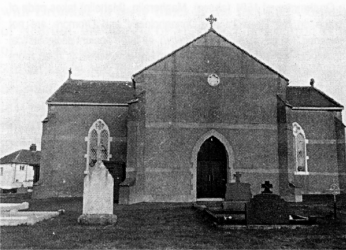
Front view of St. Colman's
Church, Kilwarlin erected 1812.
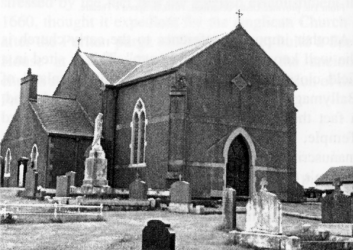
St. Colman's Church,
Kilwarlin, was erected in 1812. The church was extensively renovated
in 1967. Some of the earlier headstones in the adjoining cemetery
relate to families from the parish of Aghalee (in County Antrim),
which was part of the Dromore Diocese even though it is located deep
into the territory of the Diocese of Down and Connor. The adjoining
parochial house was newly erected in 1964; Father Tom Mooney, P.P.,
was the first occupier.
The vacancy at Magheralin., was filled on the 24th.
December 1847 by another curate, Reverend Patrick MacKay who acted as
Adm., he became the parish priest. He was transferred to Drumgath in
1864. Perhaps it would be safe to say that it was not until this period
that Magheralin. regained something like normality. In 1864, Bernard
Troy who had been the principal of the Diocesan Seminary from 1843-46
was ordained a priest by the Most Rev. Dr. Blake, in Newry Cathedral
26th. July, 1846, and after serving as a curate in Drumgath, Aghaderg
and Tullylish, he was appointed Parish Priest of Magheralin. on the
24th. December 1864. He died in 23rd. December 1870, at the age of 61,
and was interred in Lawrencetown Cemetery. At the demise of the Rev.
Bernard Troy little time was lost in arranging a new pastor to the
parish, the designate being a Newry curate, Rev. James Lowry, whose
appointment took place on 5th. January 1871. Born in Clonduff, and
educated at Maynooth, he was ordained in Newry by the Most Rev. Dr.
Blake in 1857. His sojourn in Magheralin. was short, for he retired in
1874, but no reason is given for this decision. However, he appears as
having taken up duties as a curate in Kilbroney from 1874 to 1876.
Finally, he retired to the continent and died at Courtrail, France, on
the 11th. February 1895, and his remains were interred in the burial
ground attached to St. John's Church, Courtrail.
Political and land agitation in the closing decades
of the 19th. century, led to party feelings that festered into
situations of strife. Very Reverend Fr. John McGrath succeeded Reverend
Lowry as Parish Priest on the 10th. July 1874, and took up residence in
the parochial house beside the chapel. In 1885, the church and
presbytery were attacked by a mob who smashed windows and caused other
damage. After thirteen years in Magheralin., Reverend McGrath was moved
and appointed Parish Priest of Magheradroll in 1887. His place was taken
by Very Reverend John Quail, 11th. February 1887, and he remained at
Magheralin. until 1912, the year that he succeeded his brother, Reverend
Patrick Quail, as Parish Priest of Upper Drumgooland.

The tension that had arisen in the area in the late
19th. century eventually decreased with the appointment of Very
Reverend Hugh McAvoy as Parish Priest on 5th. May 1912. A native of
Donaghmore, he was educated at Maynooth where he was ordained on 19th.
June 1882. During his ministry he held curacies at Annaclone, Aghaderg
and Shankill. He died on 3rd. February 1923, and was interred in St.
Mary's Cemetery, Barr.
Very Reverend Eugene MacPolin, was appointed
parish priest on 9th. February 1923. A native of Clonduff, he was
educated at Maynooth, and ordained by Archbishop Walsh on 24th. June
1889. During his ministry he held curacies in the Diocese of Glasgow,
1886-1889, in the Diocese of Down and Connor at Aghagallon 1890-91;
Magheralin. 1891-92; Seapatrick 1902-05; Seagoe 1905-23. He died on the
5th. January 1941, and was laid to rest after Requiem Mass in St.
Colman's Cemetery, Kilwarlin, on 8th. January. The funeral panegyric was
preached by the Reverend D. Gallery a native of the parish, who was then
Parish Priest of Leitrim
Very Reverend Daniel Pollen was appointed to
Magheralin. in 1941. He celebrated his Golden Jubilee to the Priesthood
on 12th. June 1960. During his pastorate, a new primary school opened on
10th. November 1957.
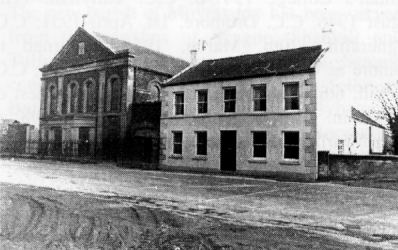
St. Patrick's Church,
Magheralin., was erected in 1843.
Very Reverend Thomas Mooney was appointed
Parish Priest on 22nd. January 1972. A native of Drumgath he was
educated at Maynooth, and was ordained by the Most Reverend Dr. Mulhern,
in Newry Cathedral, on the 10th. June 1934. During his early priestly
career he was seconded to the Diocese of Down and Connor where he served
as a curate in Ballymena, in 1934, and then moved to Donaghadee,
September 1934-35. He was recalled to his native diocese and appointed
C.C. Magheralin., October 1935-6; C.C. Lower Drumgooland; and Diocesan
Inspector of Schools 1937-50, C.C. Seagoe February 1950. Elevated as
Archdeacon of Dromore 20th. January 1984. He retired 30th. August 1987,
and went to reside in his native Drumgath.
Very Reverend John Treanor was appointed
Parish Priest on 8th. July 1963. A member of a notable Burren family who
had the distinction of having three members of the family in Holy
Orders, namely Very Reverend Frank Treanor, Parish Priest of Donaghmore,
and Very Reverend Bernard Canon Treanor, Parish Priest of Dromara. The
Reverend John Treanor was educated at St. Colman's College, Newry,
Maynooth, Firbough University, Switzerland, University College, Dublin,
and Dromantine College; where he was ordained by Most Reverend Dr.
Mulhern on 15th. June 1941. Appointed Spiritual Director of St. Colman's
College, Newry, on 15th. September 1942, then to the teaching staff,
2nd. September 1946, and President of the College, 25th. January 1970.
Appointed P.P. Magheralin. 1972; transferred as Parish Priest of
Tullylish in 1978, and, elevated to the Cathedral Chapter, 27th. January
1988. He retired on 27th. September 1998.

Very Reverend Fr. Albert McGovern. Born in
Monaghan Street, Newry, he was the son of Michael J. McGovern, merchant,
educated at Maynooth and completed. his theological studies at
Dromantine College where he was ordained by Dr. Mulhern on June 15th.
1941 He was appointed to the staff of St. Colman's College 1941-6; C.C.
Tullylish. 12th. August 1946. C.C. Dromore, 1st. April 1951; C.C.
Magheralin., 20th. March, 1955, Returned to Dromore as C.C. Ballela, 1 1
th. October, 1961; C.C. Shankill, 6th. July 1969, Appointed Parish
Priest of Magheralin. in 1978, retired 9th. August 1998, as C.C.
Kilwarlin. He died on 30th. March 1989.
Very Reverend Arthur McNeill, Parish Priest,
was appointed on 9th. August 1988. A native of Annaclone, he was
educated at St. Colman's College, Newry, and Maynooth, where he was
ordained by the Most Reverend Dr. McQuaid Archbishop of Dublin, 17th.
June 1955. On loan to the English Mission, he was recalled, and
appointed C.C. Upper Drumgooland on 13th. July 1957; C.C. Donaghmore,
21st. September, 1959; C.0 Clonallon, 18th-September 1962; C.C. Newry,
18th. November 1977; C.C. Magheralin., 24th. October, 1985. He retired
in August 2002, and is now C.C. Gilford.
Very Reverend Michael Maginn, Parish Priest,
was appointed on 21st. August 2003. A native of Lurgan, he was educated
at St. Colman's College, Newry, and Maynooth, where he achieved a B.A.
with honours in History and Sociology, and B.D. in Theology and
Scripture. He was ordained in Newry Cathedral by Most Reverend Dr.
Brooks 14th. June, 1981, and appointed C.C. Annaclone and assistant
Diocesan Advisor on Religious Education. In 1982 he left for America to
study Catechetics at Forham University, New York. On his return he was
appointed Ecclesiastical Inspector, and attached as curate to Saval,
26th. January, 1984. Assistant Diocesan Lourdes Director, 14th September
1983; C.C. Newry, 18th. August 1989; and C.C. Clonallon, 19th. August,
1996.
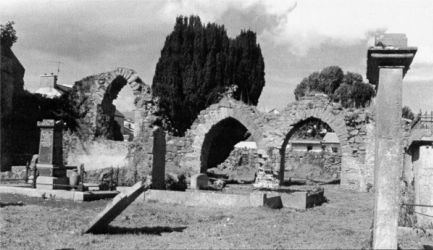
Few parishes can
demonstrate their antiquity in similar fashion to Magheralin..
In the ancient parish graveyard there are the remains of
ecclesiastical buildings from the 15th. and 16th. centuries.
Evidence of even earlier structures can be seen in parts of the
perimeter wall. The arches shown in the photograph are quite
similar to the arches of the Nuns Chapel in historic
Clonmacnoise, County Offaly.
 |